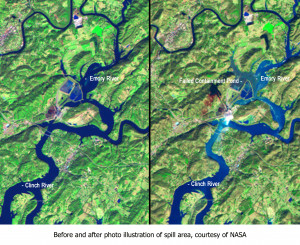Around 1 am, a retention basin containing coal ash from a power plant broke; 4.1 million m³ of sludge (ash and water) spread over a 1.6-km² area with a thickness reaching 1.8 m. The SWAN pond, as well as the EMORY and CLINCH Rivers, both tributaries of the TENNESSEE, and the WATTS BAR Dam were polluted. The sludge wave damaged power lines, a gas pipeline, a road and 54 houses, 12 of which were entirely covered and another one torn from its foundations. One person was slightly injured; energy production was not suspended, as the waste could be stored in a basin that remained structurally intact.
Utility services were restored over the next few days. The ash, categorised according to local and federal law as “non-hazardous waste”, was composed mainly of silica and contained traces of metals and radionuclides. The operator seeded the zones covered by discharge in order to avoid wind dispersion. On 1st January, 2009, an independent laboratory detected in the sampled water at the level of the discharge (both 600 m and 2,400 m downstream) metal contents (As, Cu, Ba, Cd, Cr, Pb, Hg, Ni, Tl) above the thresholds for human consumption.
On 11 May 2009, an agreement between the operator and the national Environmental Protection Agency (EPA) stipulated the pollution cleanup protocol. As a result of long-term impacts feared for human health and the environment, 3.1 million m³ of ash were extracted, then removed by rail and stored in Arrowhead (Alabama); an earthquake-resistant enclosure was built around the damaged basin. According to the operator, the total cost of these measures amounted to $975 million; during the works, both air and water quality were very closely monitored (with respectively 142,000 and 20,000 samplings over a year).
An international consulting firm commissioned at the start of January 2009 issued the conclusions of its expert evaluation on 25 June, 2009. The basin was formed of an outer enclosure built on the in situ clay and filled in the past with ash and later completed by an inner enclosure built by successive lifting steps according to the “upstream” method; the inner enclosure was positioned 70 m inside the outer enclosure. This second dam relied on ash initially deposited in liquid form within the outer enclosure. The in situ geotechnical analysis established the presence of a thin layer of atypical sludge vertically aligned with a portion of the inner enclosure lying between the natural clay (alluvial riverbed deposit) and the transported ash. This sludge originated from the direct discharge of ash via a channel in the EMORY River during the first few years of plant operations. A stratified deposit of ash and river sediment with very poor mechanical characteristics (high water content, low shear strength, sensitivity to creep) formed over a 9-cm thick part of the footprint of future retention basins. This deposit’s gradual deformation during basin filling gave rise to the break: first, sliding of the north-west portion of the inner enclosure body along a dipping rupture surface upstream of this enclosure; then crossing the 30 m of retained ash and reaching the underlying sludge layer, running parallel to it beneath the inner enclosure body before rising to the surface between the inner and outer enclosures; and finally causing liquefied sludge to be released and the entire configuration to fail.
Leaks observed by the operator at the base of the inner enclosure during the 2003 annual inspection had given rise to repairs of local instabilities and the introduction of a comprehensive drainage system on the enclosure body. Subsequent to the new instability identified in November 2006, this protective system had to be completed by drains on toe of the dam, along with drainage shafts and structural reinforcement of the base using riprap and 30 piezometers.
In August 2009, the operator had a future plan of storing wastes from this plant in dry form, as this technique had already been used at 5 other of its sites. The operator conducted an audit of all the other plants owned featuring a similar design.
On 30 November 2009, a committee of experts appointed by the State of Tennessee underscored the lack of design studies during the sequence of basin rises as well as the operator’s poor knowledge of material characteristics and facility operations. The committee recommended stopping construction upstream and applying hydraulic dam regulations to the effluent storage basins; moreover, it judged the emergency plan implementation as reasonablyefficient.
The operator was communicate on the measures adopted following the accident via the press and, between February and December 2009, purchased 150 of the polluted parcels.




